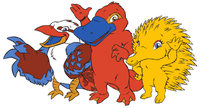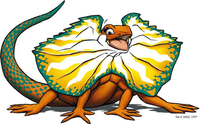Olly, Syd, Millie and Lizzie
Olly, Syd and Millie were the official mascots of the 2000 Summer Olympics and Lizzie was the official mascot of the 2000 Summer Paralympics, both held in Sydney, Australia.
| Olly, Syd and Millie | |
|---|---|
 | |
| Mascots of the 2000 Summer Olympics (Sydney) | |
| Creator | Matthew Hattan and Jozef Szekeres |
| Significance | A kookaburra (Olly), a platypus (Syd) and an echidna (Millie) named after the short term for Olympics, Sydney and Millennium |
| Lizzie | |
|---|---|
 | |
| Mascot of the 2000 Summer Paralympics (Sydney) | |
| Significance | A Frill-necked Lizard |
| Part of a series on |
|
Olly, Syd and Millie were named by Philip Sheldon from advertising agency DMBB and represented air, soil and water. Olly (from Olympics) the kookaburra represents the Olympic spirit of generosity. Syd (from Sydney) the platypus, represents the environment as well as the activity and energy of Australia and their population. Millie (from Millennium) the echidna, knows everything about technology and numerical data. The mascots were designed by Matthew Hattan and Jozef Szekeres.[1][2]
The mascot for the 2000 Paralympics was Lizzie the Frill-necked Lizard.[3] The frill of the Paralympic mascot was coloured in green and gold and represented the country via the shape. The ochre colour of Lizzie's body aimed to mirror the colour of the land. The frill neck lizard is a native Australian animal which inhabits northern parts of the country. The lizard was chosen because of its will to survive along with its tenacity, it carries the Paralympic message of power and pride to both Australians and international audiences.[4] The strength, determination and attitude of Lizzie symbolise the character traits of all Paralympic Athletes.[5]
Lizzie has been given the voice of Olivia Newton-John, a well-known Australian singer, actor and entertainer. Olivia made performances with Lizzie leading up to the Games, spreading the word about excellence within the Paralympic Community.[6]
The outstanding visibility and community engagement to Lizzie ultimately led to marketing success, unrivalled by the three olympic mascots. Lizzie captured the imagination of the public, leading to the iconic representation at the Paralympic games. The Australian Paralympic Committees noted the significant branding capitol and realised that this could be leveraged in the future.[7]
See also
- List of Olympic mascots
- List of Paralympic mascots
- List of Australian sporting mascots
- Fatso the Fat-Arsed Wombat, an unofficial mascot of the 2000 Games.
References
- "Olympische mascottes Zomerspelen". athensinfoguide.com. Retrieved 14 October 2014.
- "Syd, Olly and Millie – mascots of the 2000 Olympic Summer Games". Beijing2008. 5 August 2004. Archived from the original on 17 May 2013. Retrieved 25 October 2006.
- "A Brief History of the Olympic and Paralympic Mascots". Beijing2008. 5 August 2004. Archived from the original on 21 June 2008. Retrieved 25 October 2006.
- "Sydney 2000 Paralympic Games – Lizzy". International Paralympic Committee (IPC). n.d. Retrieved 22 August 2015.
- Brittain, Ian (2012). From Stoke-Mandeville to Stratford: A History of the Summer Paralympic Games. Illinois: Common Ground.
- "Olympic Games" (PDF). Olympic Information Center. 1997. Retrieved 16 January 2019.
- Legg, David; Gilbert, Keith (2011). "Chapter 8: Sydney 2000: Moving from Post-Hoc Legacy to Strategic Vision and Operational Partnerships". In Darcy, Simon; Appleby, Louis (eds.). Paralympic Legacies. Illinois: Common Ground Publishers. pp. 75–95.
External links
| Preceded by Sukki, Nokki, Lekki and Tsukki Nagano 1998 |
Olympic mascot Olly, Syd and Millie Sydney 2000 |
Succeeded by Powder, Copper and Coal Salt Lake City 2002 |
| Preceded by Parabbit Nagano 1998 |
Paralympic mascot Lizzie Sydney 2000 |
Succeeded by Otto Salt Lake City 2002 |